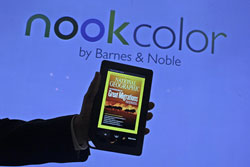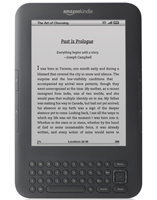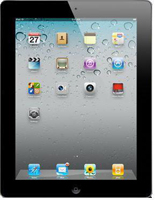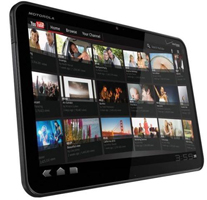A lot of people stood in line to pay $500 or more for Apple's iPad 2 when it first went on sale. Check out the Nook Color Wi-Fit E-Reader, which costs less than $200, as well as other less expensive tablet models.
 |
Barnes & Noble's Nook Color can be modified to
function as a tablet computer—
at a fraction of the cost of its rivals. |
I didn't want to spend $500 for a tablet computer. I didn't even want to spend $400.
So instead I went online and bought a brand-new tablet for a bit less.
The cost? Less than $200 ... and about 20 minutes of my time.
No kidding.
It's hardly a perfect comparison—more on this below—but the tablet is perfect for what I want. I'm not talking about one of those junk tablets from a Chinese website, either.
More from
Wall Street Journal : What the iPad 2 Means for Your Wallet
Jobs Unveils Apple's iPad 2 New Nook Packs a Colorful Punch
|
I bought a Barnes & Noble Nook Color tablet (for $190 plus tax from a temporary online promotion, down from the usual $250). And then I downloaded a very simple, perfectly legal software fix from the Internet that turned it into a fully functioning tablet running on Google's Android platform. The fix, known as a "rooting," unlocks Barnes & Noble's proprietary overlay. The instructions came via Ars Technica, a reputable site devoted to technology, and were pretty easy to follow.
I wasn't really expecting it to work. I tried it as an experiment. But the results were remarkable.
The Nook Color, which was designed mainly for reading books and magazines, is about half the size of an iPad or a Motorola Xoom. It weighs about 30% less. It runs on WiFi, but not 3G. It has an absolutely superb screen. And, once you've unlocked the software, it runs many Android applications, from email to news readers TweetDeck to, yes, Angry Birds.
It even, ironically, runs the Kindle app from Barnes & Noble's rival Amazon.com. So I can now use my Nook Color to read Kindle books.
Be aware that you perform this software hack entirely at your own risk. Barnes & Noble says it invalidates your warranty. The process ran smoothly for me, but when I read the Internet chat rooms, I found at least a few people had had problems. If it goes wrong, you're on your own.
Of course, it's hardly the same as an iPad or a Xoom or a Samsung Galaxy. It doesn't have any cameras. It has a slower processor. It's not for power users. The video support is pretty limited. A few Android programs still won't run on it. And dedicated gamers will doubtless find it frustrating.
But as a basic tablet, it's absolutely fine for me—and, I suspect, a lot of people. Indeed, I happen to prefer it to bigger rivals, because it actually slips into my overcoat pocket. (I hate having to carry things around.)
All this leads to three financial thoughts.
The first is that Barnes & Noble needs to get the lead out and let people run these applications on the Nook Color without having to jail-break it. Obviously they want to block Amazon's Kindle app, because they want customers to buy books from BarnesandNoble.com. But why block everything else? Why should I have to invalidate the warranty in order to make their product more attractive?
They'd sell a lot more of these babies if customers could run email and Facebook and so on out of the box. (The minute I catch myself playing games on this thing, it goes on eBay. But most people want to.) And once they get these Nook Colors into people's hands as an Android tablet, they would work pretty well as a Trojan horse to sell Barnes & Noble books and magazines as well. In other words, it would help the company's business model, not hinder it.
Barnes & Noble currently offers just a few applications, such as Pandora, the Internet music service. The company promises a full app store in due course. But it's been saying that since the product went on sale last fall. A company spokeswoman would only say yesterday that it is still "in the works."
Huh? Time is not this company's friend. It should be seizing the moment while it can. Barnes & Noble stock, which was north of $40 five years ago, closed Tuesday at $11.67, a 14-year low. Not even the travails of arch-rival Borders Group, which has filed for Chapter 11 bankruptcy protection and is closing many of its stores, is helping.
The second observation is that these tablets are probably going to become cheap, near-commodity items, and maybe sooner than you think.
Think about this. Barnes & Noble—a company that is, ahem, hardly in the forefront of technological innovation—has managed to put together a pretty good Android tablet from scratch in short order, and is selling it for $250 (and even less if, like me, you catch a promotion). It's not a top-of-the-range model, but it does include a superb screen—and analysts will tell you that's typically one of the most expensive parts of a tablet.
Investors in Apple, Motorola Mobility, Samsung, Hewlett-Packard, Research In Motion and others are hoping for great things from tablet computers. It's all anyone wants to talk about—the huge profits to come from all these tablets and the "cloud computing" services they use. Apple alone is the second-most-valuable company in the world, with an enterprise value of more than $300 billion.
Count me as deeply Missourian about the long-term profits likely to come from this entire industry. In the short run, there may be fantastic money to be made. In the long term, tablets will be a dime a dozen. Every platform will have all the apps you need. Any brand or model is going to have a tough challenge maintaining a competitive advantage over another. Someday we're going to look back and laugh at the day when people thought tablets—or smartphones—were exciting and profitable businesses to be in.
If Barnes & Noble can do it, anyone can.
The third financial thought? This tablet saved me $200 compared to the cheapest of its competitors. No, it's not a king's ransom. And it was mainly just an experiment. But this is real money nonetheless. And, critically, it's worth more than many people think.
How easily we overlook the math. Money I save today will compound enormously by the time I actually need it, which will be when I retire. We are likely to spend 20 to 30 years in retirement, and as we all know the entitlements system is struggling with rocketing costs.
If investments earn an average return of about 5% above inflation over the next 30 to 35 years, that $200 I saved will grow by a factor of five. I'll have an extra $1,000 or so, in today's dollars, in my 70s.
Not bad.
Decisions, Decisions
A slew of new and upgraded tablets and e-readers are on the market. See how the base models for the different devices stack up.
 |
| Kindle |
Kindle
An e-reader designed specifically for reading books. It's lighter, works better in sunlight and has longer battery life than an iPad, but it lacks color and a touch screen. The Kindle has a Web browser and some apps.
Price: $139 with Wi-Fi, $189 with 3G and Wi-Fi
Weight: 8.5 - 8.7 oz.
Size: 7.5" x 4.8" x 0.335"
Screen: 6", grayscale
Connectivity: 3G, Wi-Fi
Capacity: 4GB (3GB for user content)
Nook Color
While the original Nook offered a gray-scale reading screen and a thin, color touch strip for browsing the bookstore, a model released in November is one big color touch screen. It connects to the Web using only Wi-Fi. Like the Kindle, the Nook Color has a Web browser and some apps but no dedicated email program or way to access an app store.
Price: $249
Weight: 15.8 oz.
Size: 8.1" x 5.0" x 0.48"
Screen: 7", color
Connectivity: Wi-Fi
Capacity: 8GB
 |
| Apple IPad 2 |
Apple iPad 2
The iPad 2, which has a dual-core microprocessor and two video cameras, is thinner and lighter than the original iPad. The new version starts at $499, the same price as the original model. It will be available in black and white colors and offered by both AT&T Inc. and Verizon Wireless.
Price: $499 (Wi-Fi), $629 (Wi-Fi and 3G)
Weight: 1.33 - 1.35 pounds
Size: 9.5" x 7.31" x 0.34"
Screen: 9.7", full-color
Connectivity: 3G, Wi-Fi
Capacity: 16GB
Samsung Galaxy Tab
The new 10.1-inch Android-powdered Galaxy Tab is launched in partnership with Vodafone Group PLC. The new tablet will support websites build using Adobe Flash.
Price: $499.99 - $599.99 (depending on carrier)
Weight: 13.23 - 13.58 oz.
Size: 7.48" x 4.74" x 0.47" (approximate)
Screen: 10.1", full-color
Connectivity: 3G, Wi-Fi
Capacity: 16GB
 |
| Motorola Xoom |
Motorola Xoom
Motorola Mobility Inc.'s new Xoom tablet, based on Google Inc.'s Android operation system, has front-and rear-facing video cameras. It is the first iPad challenger to run Honeycomb, an elegant new version of Google's Android operating system designed especially for tablets.
Price: $799.99
Weight: 1.6 pounds
Size: 9.8" x 6.6" x 0.5"
Screen: 10.1", full-color
Connectivity: 3G, Wi-Fi
No comments:
Post a Comment